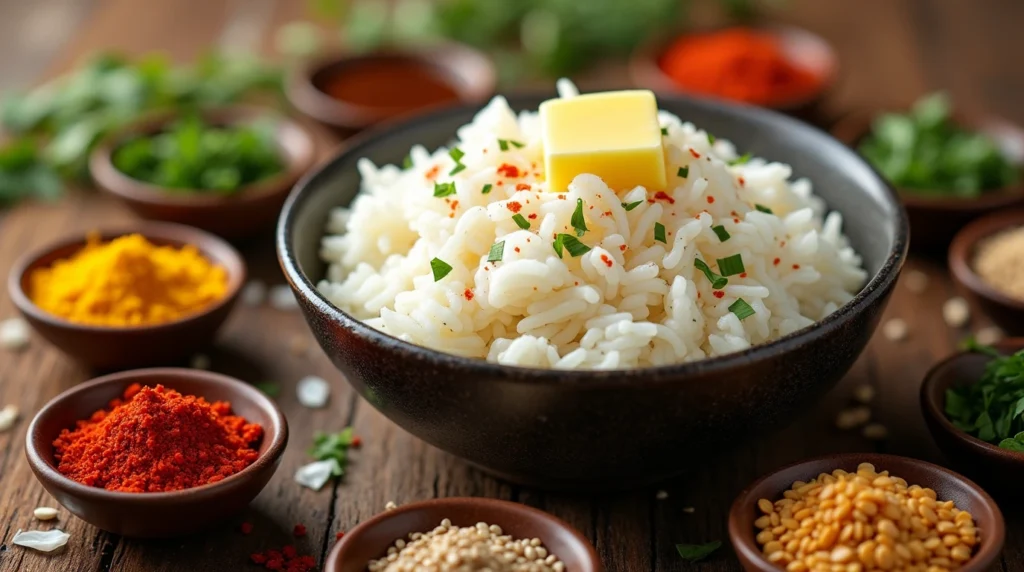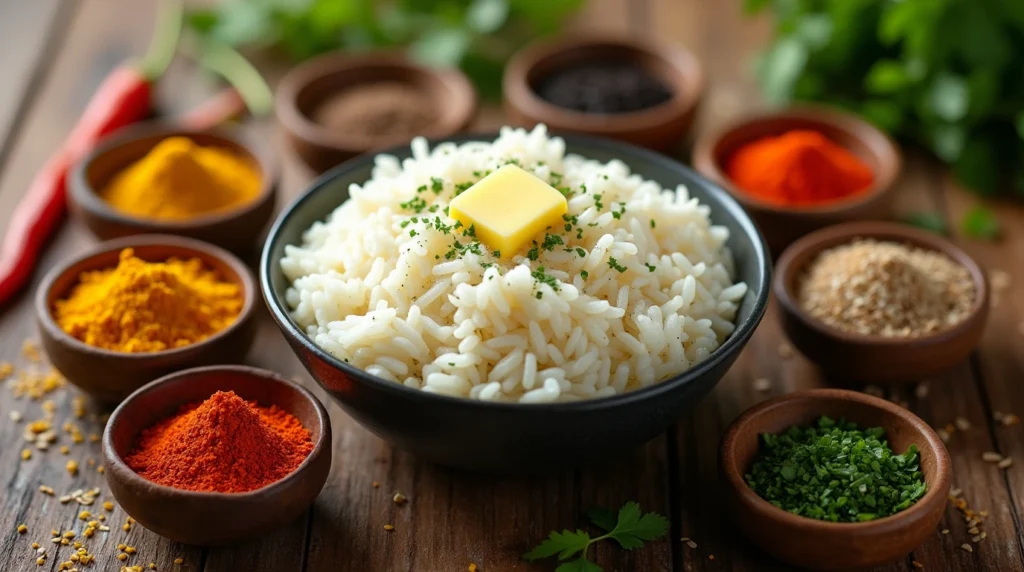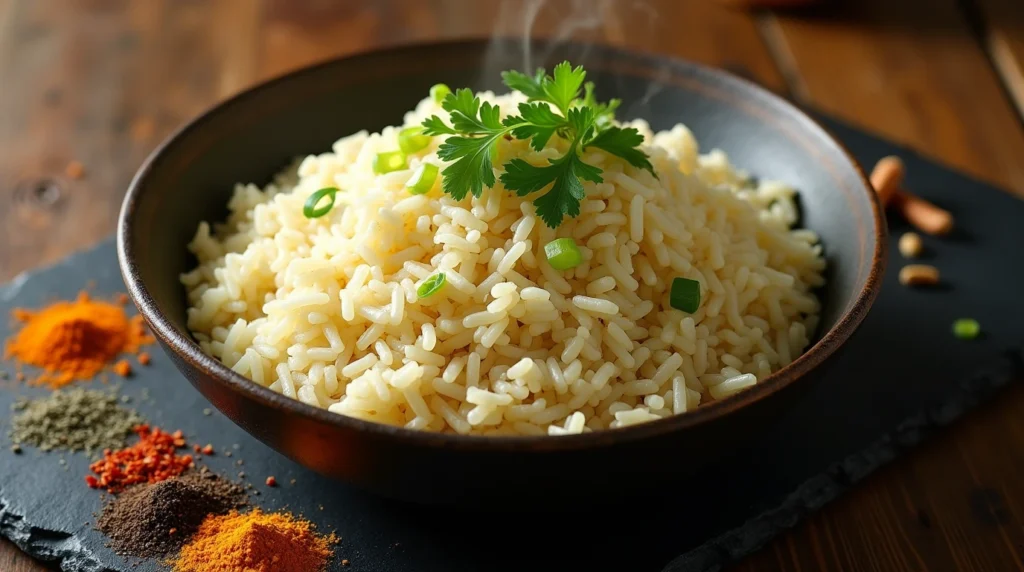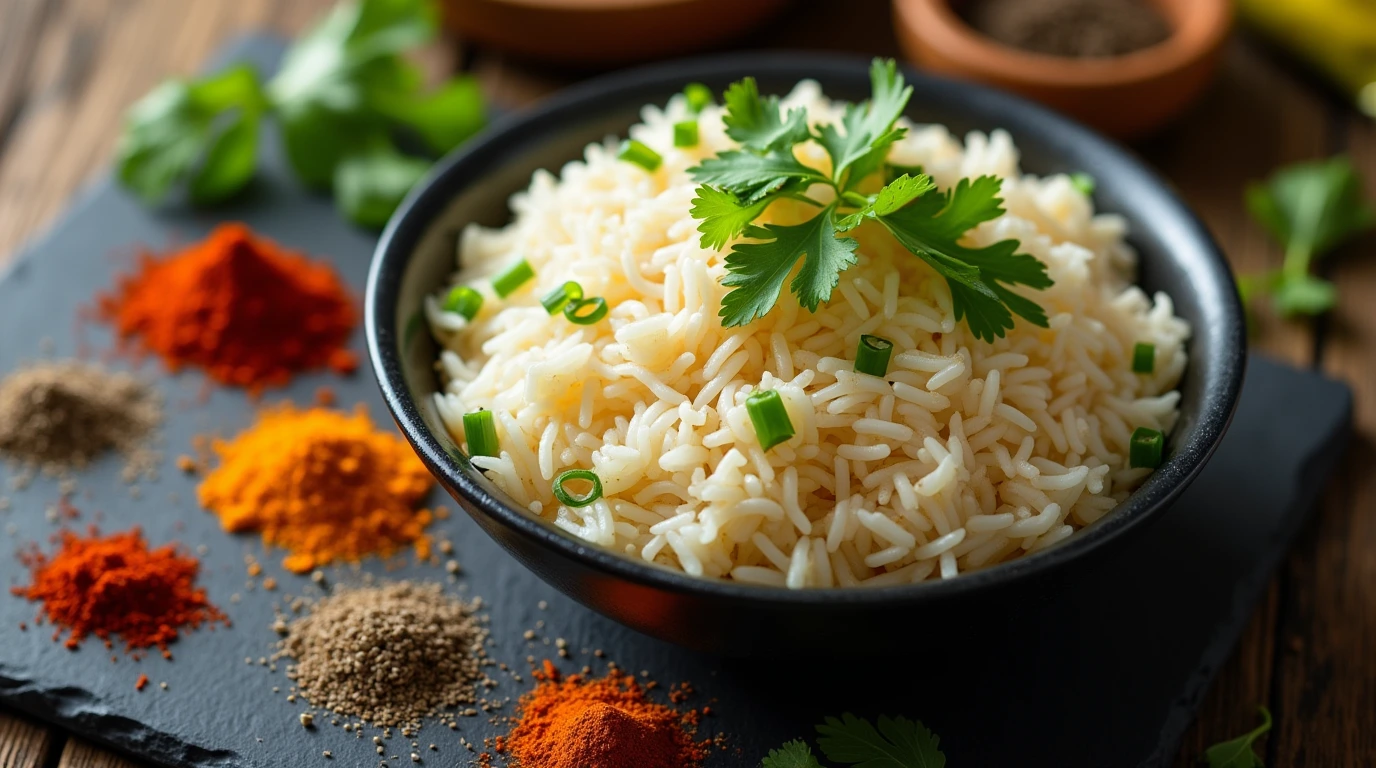Rice is a staple food enjoyed by cultures worldwide. Yet, many find plain rice a bit dull. For those looking to spice up their dishes, knowing what seasoning makes rice taste better is key. This article will share the best rice seasoning tips to boost flavor and excitement in your meals.
From exploring different types of rice to discovering various seasoning ideas, you’ll learn how to make your rice dishes stand out. You’ll gain insight into adding flair and creativity to your rice dishes.
Whether you’re hosting a dinner or just want a tasty side dish, finding the secret ingredients for sassy rice recipes can be a game-changer. Ready to make your meals more enticing? Let’s explore the world of flavored rice!
Key Takeaways
- Rice is enjoyed globally, yet often lacks flavor without seasoning.
- Simple changes like using stock can significantly enhance taste.
- Different types of rice have distinct flavor profiles and uses.
- Fresh herbs and spices can transform plain rice into gourmet dishes.
- Exploring various cooking techniques, like sautéing, enhances overall flavor.
Understanding the Basics of Rice
Rice is a versatile grain enjoyed all over the world. Knowing its types and how to cook it is key. For example, short grain and long grain rice differ in texture and taste.
Rice is a big part of many diets. It’s a main source of carbs, giving us energy. Whole grain rice adds fiber and vitamins, making it even better for you.
Getting the right texture and taste from rice depends on its type. Some grains are best steamed, while others need boiling or absorption. Rinsing rice before cooking helps it stay fluffy. These methods are important for both beginners and seasoned cooks.
Different Types of Rice and Their Uses
Exploring the various types of rice can greatly improve your cooking. Different rice varieties, like short grain and long grain, have unique textures and flavors. These differences make them perfect for different cuisines.
Short Grain vs Long Grain Rice
Short grain rice, such as Arborio and sushi rice, is sticky. This makes it great for dishes where rice clumps, like sushi or risotto. Long grain rice, like basmati and jasmine, stays fluffy and separate. This quality is perfect for spiced dishes, allowing for a variety of flavors.
Knowing these differences helps cooks choose the right rice for their recipes.
The Best Rice for Different Cuisines
Choosing the right rice can make a dish better. For example, basmati rice is great in Indian curries because of its aroma. Sushi rice, on the other hand, is key in Japanese cuisine. It needs special seasoning with rice vinegar, sugar, and salt to taste authentic.
Using the right rice ensures a dish tastes true to its culture. This makes the dining experience even better.
| Type of Rice | Characteristics | Best Uses |
|---|---|---|
| Short Grain Rice | Sticky and chewy | Rice for sushi, risotto |
| Long Grain Rice | Fluffy and separate | Rice for curries, pilafs |
| Basmati Rice | Aromatic and long | Indian dishes |
| Jasmine Rice | Fragrant and slightly sticky | Thai cuisine |
| Brown Rice | Nutty flavor and chewy texture | Salads, grain bowls |
| Black Rice | Sweet and slightly chewy | Salads, desserts |
Why Seasoning is Important for Rice
Seasoning rice is key to making it taste great and fit well with other foods. Without seasoning, rice can taste bland. But with the right spices and herbs, it becomes a highlight of the meal.
For example, mixing ¼ cup of rice vinegar, 1 tablespoon of sugar, and 1 teaspoon of salt is a good start. This mix gives rice a bright, slightly sweet flavor. It’s perfect for sushi rice and can make simple dishes taste amazing.
Different rice types like jasmine, basmati, and sushi rice pair well with various seasonings. Chefs like Heena Patel choose basmati for its unique aroma and texture. Washing basmati rice before cooking improves its texture.
Using stock instead of water adds more flavor to rice. Chicken or vegetable stock works well. Adding garlic, turmeric, and fresh herbs can make rice even more flavorful.
Seasoning not only changes how rice tastes but also affects how much people enjoy it. People often go back to places that serve great seasoned rice. This shows how important seasoning is for a good dining experience.

| Seasoning Type | Purpose | Recommended Quantity |
|---|---|---|
| Rice Vinegar | Adds tanginess | ¼ cup per cup of rice |
| Sugar | Balances flavors | 1 tablespoon per cup of rice |
| Salt | Enhances overall taste | 1 teaspoon per cup of rice |
| Stock | Adds depth and nutrition | Replace water with stock |
| Garlic | Provides umami | As desired |
| Fresh Herbs | Enhances aroma and flavor | As desired |
In conclusion, learning to season rice well is a valuable skill. It makes rice more flavorful and versatile in different dishes. With the right seasonings, anyone can make their rice dishes stand out.
What Seasoning Makes Rice Taste Better?
Choosing the right seasoning is key to making rice taste great. There are many ways to make plain rice into a tasty dish. Using stock instead of water is a popular method that adds a rich flavor to rice.
Fresh herbs like basil, cilantro, and parsley can also make rice taste better. They add a fresh taste that goes well with many meals. The right spices can also enhance the flavor of rice.

Using Stock for Better Flavor
Stock, like chicken or vegetable, makes rice taste much better than water. It adds a depth of flavor that water can’t match. This is great for dishes with meat or vegetables, as it ensures everything tastes good together.
The Impact of Fresh Herbs
Fresh herbs like dill, thyme, and cilantro add flavor and make the dish look good. Mixing them in after cooking brightens the dish and makes it smell great. They pair well with meats or beans, making every bite flavorful.
Choosing the Right Spices
Spices like garlic powder, onion powder, paprika, and turmeric can change the taste of rice. Each spice adds its own flavor and health benefits. Trying different spice combinations can lead to exciting rice dishes that you’ll love.
| Seasoning Method | Flavor Impact | Common Ingredients |
|---|---|---|
| Using Stock for Rice | Adds depth and richness | Chicken broth, vegetable broth |
| Fresh Herbs for Rice | Brightens and enhances aroma | Basil, cilantro, parsley, thyme |
| Choosing the Right Spices | Creates unique flavors and health benefits | Garlic powder, onion powder, turmeric, paprika |
The Art of Rinsing Rice
Rinsing rice is key in rice preparation, crucial for many dishes. It removes excess starch, making the rice fluffy. Without rinsing, rice can become sticky and unpleasant.
Each rice type needs its own rinsing method. For example, basmati and jasmine rice benefit a lot from rinsing. Rinsing until the water is clear is the best way to remove starch and impurities. Chefs suggest different rinsing techniques for different rice types, and taste tests can help find the best method.
To improve your rice cooking, try soaking basmati rice for 15 to 30 minutes. Leah Cohen recommends this. Also, using stock instead of water can add flavor, as Zouhair Bellout suggests. Remember, rinsing rice is not just a step; it’s essential for a great dish.
| Rice Type | Rinsing Duration (minutes) | Soaking Duration (minutes) |
|---|---|---|
| Basmati | 2-3 | 15-30 |
| Jasmine | 3-4 | 5-10 |
| Arborio | 2-3 | Not required |
| Sushi Rice | 3-5 | 30-60 |
Flavorful Techniques to Enhance Rice
To make your rice dishes better, try specific cooking methods. Sautéing aromatics before cooking the rice is a great way to start. This method adds rich flavors from the beginning. Onions, garlic, and spices are common choices, sautéed in butter or oil.

Sautéing Aromatics
Sautéing is a key step in adding flavor to rice. Begin by heating a skillet over medium heat and adding fat. Onions and garlic are favorites because they add a deep flavor that goes well with rice. Cook them until they’re translucent and smell great, capturing the dish’s essence.
The Role of Heat in Flavor Extraction
Cooking changes rice’s texture and helps release flavors. Adjusting the heat lets aromatics give off their full flavor. Keep the temperature steady to make sure the rice soaks up the flavors without getting too wet. This balance makes the rice taste better and more satisfying.
| Technique | Description | Benefits |
|---|---|---|
| Sautéing Aromatics | Cooking onions, garlic, or spices in fat before adding rice. | Enhances overall flavor profile. |
| Adjusting Heat | Regulating temperature to promote even cooking. | Facilitates flavor absorption and prevents sogginess. |
Popular Seasoning Ideas for Rice
Seasoning rice can turn a simple dish into a flavorful main attraction. Garlic butter rice, lemon herb rice, and coconut rice are among the favorites. They offer unique tastes that fit different meals.
Garlic and Butter Rice
Garlic and butter rice combines butter’s richness with garlic’s aroma. It makes rice a comforting side dish. To make it, sauté garlic in butter, then add cooked rice. This coats each grain with flavor.
Lemon and Herb Rice Variations
Lemon herb rice adds freshness to any meal. It uses herbs like parsley and thyme, with lemon zest and juice. It’s great with seafood or grilled chicken, offering a refreshing contrast. Choose long-grain rice for a fluffier texture.
Coconut Rice: A Sweet Twist
Coconut rice adds sweetness to your meal. It uses coconut milk for a creamy, tropical taste. It’s perfect with spicy dishes, balancing heat with sweetness. It goes well with curries or barbecued meats.
Additional Ingredients for Flavor Boost
Adding more to your rice than just seasonings can make a big difference. Mixing in different ingredients can turn your dish into something special. Broths add depth, while veggies and proteins make the meal more nutritious and filling.
Using Broths and Stocks
Broths, like chicken or vegetable stock, are great for adding flavor to rice. Chicken broth is a favorite in rice pilaf, giving it a savory taste. Coconut milk adds creaminess and works well with spices, making the dish luxurious.
Choosing these liquids over water can really change your rice dishes for the better.
Adding Vegetables and Proteins
Adding veggies like carrots, broccoli, or avocados makes rice look and feel better. They add important nutrients and make the meal complete. Proteins, such as shredded chicken or legumes, make the dish more satisfying.
Mixing sautéed veggies with spices can make any rice dish exciting and healthy.
Creative Seasoning Techniques
Rice is a versatile base for many flavors. You can infuse spices during cooking or add exciting sauces. This turns a simple meal into a feast for the taste buds.
Infusing Rice with Spices
Adding spices to rice makes it taste better. Try toasting the rice with garlic and onion powder for a rich flavor. Using rice vinegar, sugar, and salt gives it a sweet and tangy taste.
Seasoning at the right time is key. Chef Abreu says to season the liquid or grains before adding it. Also, season the rice after it’s cooked. This makes dishes like arroz con gandules even more flavorful.
Experimenting with Sauces and Marinades
Trying different sauces for rice can create unique flavors. Soy sauce, teriyaki, or coconut milk add Asian or tropical tastes. Adding saffron or miso brings unexpected flavors.
Chefs and home cooks love this trend. It lets them customize dishes to their liking. A little curry powder can make a dish taste like Indian food. Ginger adds depth to flavors.
Using these seasoning techniques can change rice into something amazing. It opens up a world of culinary exploration. Cooks can enjoy their creativity and the delicious results.
Sassy Rice Recipe Ideas
Creative and flavorful rice recipes can make any meal better. Each dish highlights rice as the main attraction. Try these sassy rice recipes for a burst of flavor.
Garlic Butter Rice Recipe
The garlic butter rice recipe adds a rich, savory taste to any dish. Start by cooking minced garlic in butter until it smells great. Then, mix in cooked rice for a tasty base.
For a twist, add herbs like parsley or thyme. This side dish goes well with grilled meats or roasted veggies.
Saffron Rice Recipe
Saffron rice adds a touch of luxury to your meals. Begin by toasting saffron strands in a pan to boost their flavor. Mix it with rice and your favorite liquid, keeping a 2:1 ratio.
The saffron turns the rice a beautiful golden color. It looks stunning with seafood or chicken.
Mushroom Rice Recipe
Start the mushroom rice by simmering mushrooms in olive oil until they’re soft. Then, add cooked rice, broth, and spices to enhance the earthy taste. Adding garlic and fresh herbs adds depth.
| Recipe | Key Ingredients | Preparation Time | Cooking Time |
|---|---|---|---|
| Garlic Butter Rice | Rice, Garlic, Butter, Herbs | 10-15 minutes | 15 minutes |
| Saffron Rice | Rice, Saffron, broth, Spices | 5-10 minutes | 20-25 minutes |
| Mushroom Rice | Rice, Mushrooms, Broth, Garlic | 10 minutes | 20 minutes |
These sassy rice recipes are perfect for experimenting. Try different grains or proteins to match your taste. Enjoy these tasty dishes that make your meals special.
Common Mistakes When Seasoning Rice
Even the most skilled cooks can make seasoning mistakes when cooking rice. One common error is over-salting, which can overpower the dish’s taste. Not matching rice with the right flavors can also result in dull meals.
Many forget to rinse rice before cooking. This step is key to remove excess starch and prevent clumps. Assuming all rice needs the same cooking method is another common cooking pitfall that can cause uneven results.
Adding dry spices like garlic and onion powder can sometimes result in bland flavors. Using MSG, often found in yellow rice recipes, may not be to everyone’s taste. There are many other seasonings available, like a mix of rice vinegar, sugar, and salt for each cup of rice.
Sushi rice is seasoned with a simple yet effective mix of rice vinegar, sugar, and salt. This shows how important flavor and technique are in cooking.
Chef JJ Johnson stresses the importance of timing. Adding salt at the end of cooking helps flavors absorb better. Some cooks use pickle brine, beer, or coconut water for unique flavors, showing rice’s versatility.
Consistency in cooking is key. Cooking rice at too high a temperature can make grains split, ruining the texture. Letting the rice sit in its steam for about ten minutes after cooking helps it heat evenly.
Knowing these rice cooking errors helps improve your technique. Different rice types need different water ratios for the best results. Brown rice, for example, needs a 1:2 ratio.
Rinsing rice not only improves its texture but also prevents bacteria growth. This is important to avoid food poisoning. Always store leftover rice in an airtight container in the fridge and reheat it only once.
Tips for Perfectly Cooked Flavorful Rice
Getting your rice just right takes focus on timing and temperature. These details are key to making your rice dishes stand out. Using the right tips can make your rice both tender and flavorful.
Time and Temperature Considerations
Timing and temperature are essential for fluffy, tasty rice. For example, long grain white rice cooks best in 18-20 minutes on a medium-low heat. Use a 1:2 rice-to-liquid ratio, and chicken broth for extra flavor.
Each type of rice needs its own cooking time. Brown rice, for example, needs more water and time. Knowing these specifics helps avoid common mistakes like undercooked or burnt rice.
Try new flavors and cooking methods to make your rice dishes even better. Always rinse the rice first to avoid a clumpy texture.
Conclusion
Learning to make rice is a fun journey of discovery and creativity. We’ve shown you key techniques and ingredients to boost rice flavors. Whether you use the absorption method or a rice cooker, seasoning rice right can turn a simple dish into a feast.
Try adding spices like garam masala, cumin, and turmeric to white rice. It makes a big difference, making rice a great side dish for any meal.
Remember, use ghee, butter, or oil wisely for a healthier dish without losing flavor. Brown rice and mixed grains offer unique tastes and health perks. Adding fried onions, yogurt, and chutneys can make your rice dish stand out.
Don’t throw away leftovers. Turn them into tasty fried rice with soy sauce and veggies. Adding sesame oil, ginger, and garlic not only flavors but also enriches your dish. Let your creativity in cooking shine!
FAQ
What seasoning makes rice taste better?
To make rice taste better, use stock or broth, fresh herbs, and spices. Try different combinations to find your favorite flavor.
How do I properly rinse rice before cooking?
Rinsing rice removes extra starch, making it fluffier. Rinse it in cold water until the water is clear. This helps it cook well and stay separate.
What are some popular rice seasoning ideas?
Garlic and Butter Rice adds a savory taste. Lemon and Herb Rice brings freshness. Coconut Rice adds a sweet flavor. Each adds a special touch to your meals.
How can I enhance the flavor of rice without adding too much salt?
Use rich broths, fresh herbs, and sautéed aromatics to flavor rice. Spices like garlic, turmeric, or curry powder add depth without too much salt.
Why is seasoning important for rice?
Seasoning turns rice from a simple side dish into a flavorful dish. It’s key to making meals delicious and balanced.
What types of rice are best for different dishes?
Arborio rice is great for risotto. Basmati and jasmine rice are best for spiced dishes. The right rice type enhances flavor and texture.
Can I experiment with rice seasonings and flavors?
Yes! Mixing spices during cooking or adding sauces and marinades can create new flavors. It’s a fun way to get creative with rice.
What common mistakes should I avoid when seasoning rice?
Avoid over-salting, not rinsing the rice, and cooking it wrong. These mistakes can make rice taste bland or have a bad texture.
What are some sassy rice recipe ideas?
Try Garlic Butter Rice for a savory treat. Saffron Rice adds luxury. Mushroom Rice offers earthy flavors. Each adds a unique twist to your meals.

